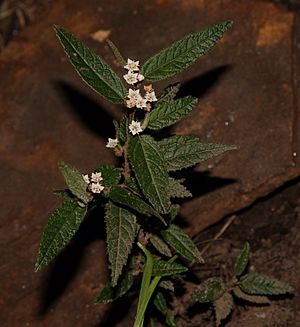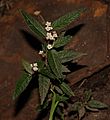Kerrawang facts for kids
Quick facts for kids Kerrawang |
|
|---|---|
 |
|
| A young plant cultivated in Sydney. | |
| Scientific classification | |
| Genus: |
Commersonia
|
| Species: |
dasyphylla
|
| Synonyms | |
|
|
The kerrawang (scientific name: Commersonia dasyphylla) is a type of shrub. It belongs to the Malvaceae family, which also includes plants like hibiscus and cotton. This plant grows naturally in eastern Australia.
A scientist named Henry Cranke Andrews first described the kerrawang in 1810. He called it Commersonia dasyphylla. Later, in 1826, another botanist, Robert Sweet, moved it to a different group called Rulingia. But in 2011, scientists decided to use its original name again.
The name Commersonia honors Philibert Commerson. He was a French naturalist from the 1700s. The species name dasyphylla comes from Ancient Greek words. Dasys means "hairy" and phyllon means "leaf". This name describes the soft, cotton-like hairs on the plant's leaves.
Contents
What the Kerrawang Looks Like
The kerrawang is a shrub that can grow from 1 to 4 meters (about 3 to 13 feet) tall. Its leaves are dark green and have a wrinkled look. They are usually 3–7 cm (1–3 inches) long and 0.5–3 cm (0.2–1.2 inches) wide. The leaves are shaped like a spear or an egg, and their edges can be toothed or lobed. The stems of the plant are covered in fine hairs.
Small flowers appear on the kerrawang from September to January. These flowers are usually white, but sometimes they can be pale pink. They are about 0.8 cm (0.3 inches) across. After the flowers, the plant produces hairy brown seed capsules.
Where the Kerrawang Grows and Lives
The kerrawang is found across eastern Australia. This includes southeastern Queensland, all of New South Wales, and eastern Victoria. It prefers to grow in gullies within forested areas.
Flies are likely the main insects that help pollinate the kerrawang's flowers. Native bees, beetles, and moths that fly during the day might also help. If there is a bushfire, the kerrawang plant will die. However, new plants can grow from seeds that survived the fire.
In Victoria, the kerrawang is considered a "threatened" species. This means it needs protection to survive. It is listed as "vulnerable" on the state's official list of rare or threatened plants.
How People Use Kerrawang
The local Cadigal people of Sydney used the kerrawang's strong fibers. They would use these fibers to make baskets. It's important not to confuse the kerrawang with the kurrajong. The kurrajong is a different Australian plant, a tree, whose bark is used to make twine.
The kerrawang was first grown in England in 1819. Back then, it was called Rulingia pannosa. It is a fast-growing shrub that looks nice in gardens. It grows best in places with some shade and soil that drains well. The soil should also be slightly acidic. Kerrawang plants easily produce seeds, and you can grow new plants from these seeds or from cuttings.
- An image of the kerrawang among other plants at Australian-Insects.com
Images for kids


